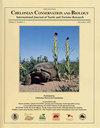Movements of Olive Ridley Turtles (Lepidochelys olivacea) in the Bay of Bengal, India, Determined via Satellite Telemetry
IF 0.8
4区 生物学
Q3 ZOOLOGY
引用次数: 4
Abstract
Abstract The migratory movements of 14 olive ridley turtles (Lepidochelys olivacea) in the Bay of Bengal were studied using satellite telemetry during 2009–2010. Tracking data show that olive ridley turtles undertake open-ocean migrations in the bay and exhibit migratory corridor between foraging habitat of Sri Lanka and nesting sites along the Odisha coast of India. Tracking durations ranged 7–331 d (mean = 151 ± 95.9 d). The tracked turtles had a mean traveling speed of 2.49 ± 0.02 km/hr and moved an average of 31.7 km/d, remaining within a mean distance of 163.28 ± 50.9 km (range, 1–535 km) from the east coast of India. Turtles occupied waters with sea surface temperature (SST) ranging from 24°C to 31°C with chlorophyll concentrations of 0 to 3.9 mg/m3. Our study confirms that olive ridley turtles in the Bay of Bengal move within a broad range of SSTs and chlorophyll a concentrations; no correlation was found between turtle movements and these 2 oceanographic parameters (r2 = 0.02, n = 77). Our data indicate that many habitats within the Bay of Bengal are important for olive ridley turtles and that the entire bay should be considered a priority conservation region for this vulnerable species.印度孟加拉湾橄榄蠵龟(Lepidochelys olivacea)的活动,由卫星遥测测定
摘要2009-2010年,利用卫星遥测技术研究了14只橄榄脊龟(Lepidochelys olivacea)在孟加拉湾的迁徙活动。追踪数据显示,橄榄脊龟在海湾进行公海迁徙,并在斯里兰卡的觅食栖息地和印度奥迪沙海岸的筑巢地之间呈现迁徙走廊。追踪持续时间为7–331 d(平均值=151 ± 95.9d)。被追踪的海龟平均行进速度为2.49 ± 0.02公里/小时,平均移动31.7公里/天,保持在163.28的平均距离内 ± 距离印度东海岸50.9公里(1–535公里)。海龟占据的海水表面温度(SST)在24°C至31°C之间,叶绿素浓度为0至3.9 mg/m3。我们的研究证实,孟加拉湾的橄榄脊龟在SST和叶绿素a浓度的大范围内活动;海龟的活动与这两个海洋学参数之间没有相关性(r2 = 0.02,n = 77)。我们的数据表明,孟加拉湾内的许多栖息地对橄榄脊龟很重要,整个海湾应该被视为这种脆弱物种的优先保护区。
本文章由计算机程序翻译,如有差异,请以英文原文为准。
求助全文
约1分钟内获得全文
求助全文
来源期刊
CiteScore
1.70
自引率
14.30%
发文量
17
审稿时长
>12 weeks
期刊介绍:
Chelonian Conservation and Biology is a biannual peer-reviewed journal of cosmopolitan and broad-based coverage of all aspects of conservation and biology of all chelonians, including freshwater turtles, marine turtles, and tortoises. Manuscripts may cover any aspects of turtle and tortoise research, with a preference for conservation or biology. Manuscripts dealing with conservation biology, systematic relationships, chelonian diversity, geographic distribution, natural history, ecology, reproduction, morphology and natural variation, population status, husbandry, community conservation initiatives, and human exploitation or conservation management issues are of special interest.

 求助内容:
求助内容: 应助结果提醒方式:
应助结果提醒方式:


